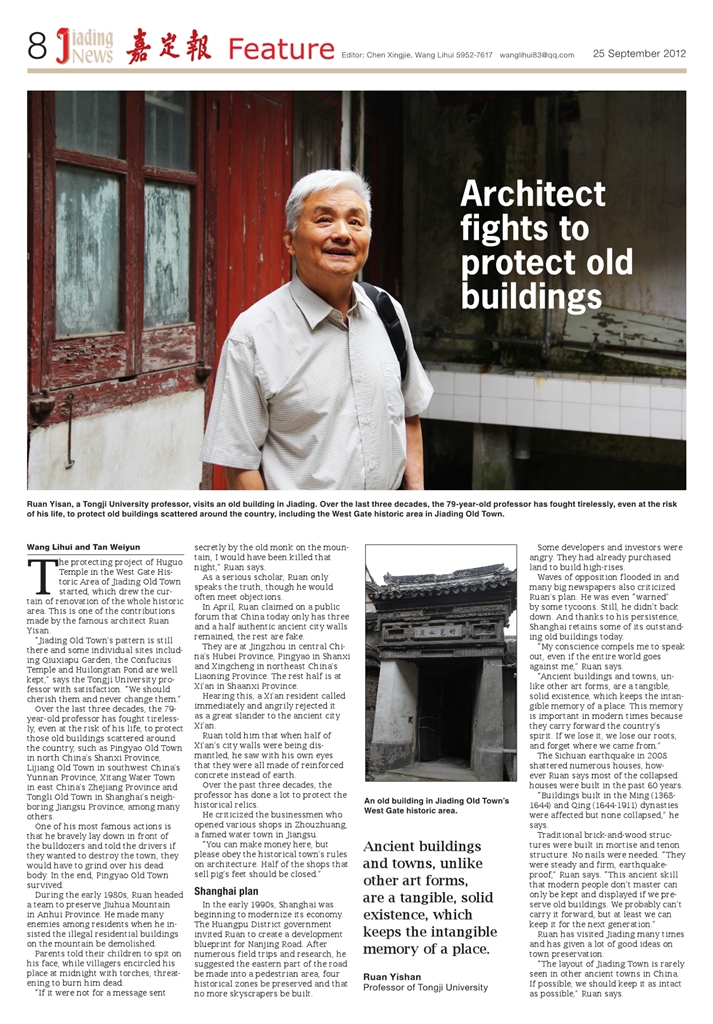

Architect fights to protect old buildings

Ruan Yisan, a Tongji University professor, visits an old building in Jiading. Over the last three decades, the 79-year-old professor has fought tirelessly, even at the risk of his life, to protect old buildings scattered around the country, including the West Gate historic area in Jiading Old Town.

An old building in Jiading Old Town’s West Gate historic area.
Ancient buildings and towns, unlike other art forms, are a tangible, solid existence, which keeps the intangible memory of a place.
Ruan Yishan Professor of Tongji University
Wang Lihui and Tan Weiyun
The protecting project of Huguo Temple in the West Gate Historic Area of Jiading Old Town started last month, which drew the curtain of renovation of the whole historic area. This is one of the contributions made by the famous architect Ruan Yisan.
“Jiading Old Town’s pattern is still there and some individual sites including Qiuxiapu Garden, the Confucius Temple and Huilongtan Pond are well kept,” says the Tongji University professor with satisfaction. “We should cherish them and never change them.”
Over the last three decades, the 79-year-old professor has fought tirelessly, even at the risk of his life, to protect those old buildings scattered around the country, such as Pingyao Old Town in north China’s Shanxi Province, Lijiang Old Town in southwest China’s Yunnan Province, Xitang Water Town in east China’s Zhejiang Province and Tongli Old Town in Shanghai’s neighboring Jiangsu Province, among many others.
One of his most famous actions is that he bravely lay down in front of the bulldozers and told the drivers if they wanted to destroy the town, they would have to grind over his dead body. In the end, Pingyao Old Town survived.
During the early 1980s, Ruan headed a team to preserve Jiuhua Mountain in Anhui Province. He made many enemies among residents when he insisted the illegal residential buildings on the mountain be demolished.
Parents told their children to spit on his face, while villagers encircled his place at midnight with torches, threatening to burn him dead.
“If it were not for a message sent secretly by the old monk on the mountain, I would have been killed that night,” Ruan says.
As a serious scholar, Ruan only speaks the truth, though he would often meet objections.
In April, Ruan claimed on a public forum that China today only has three and a half authentic ancient city walls remained, the rest are fake.
They are at Jingzhou in central China’s Hubei Province, Pingyao in Shanxi and Xingcheng in northeast China’s Liaoning Province. The rest half is at Xi’an in Shaanxi Province.
Hearing this, a Xi’an resident called immediately and angrily rejected it as a great slander to the ancient city Xi’an.
Ruan told him that when half of Xi’an’s city walls were being dismantled, he saw with his own eyes that they were all made of reinforced concrete instead of earth.
Over the past three decades, the professor has done a lot to protect the historical relics.
He criticized the businessmen who opened various shops in Zhouzhuang, a famed water town in Jiangsu.
“You can make money here, but please obey the historical town’s rules on architecture. Half of the shops that sell pig’s feet should be closed.”
Shanghai plan
In the early 1990s, Shanghai was beginning to modernize its economy. The Huangpu District government invited Ruan to create a development blueprint for Nanjing Road. After numerous field trips and research, he suggested the eastern part of the road be made into a pedestrian area, four historical zones be preserved and that no more skyscrapers be built.
Some developers and investors were angry. They had already purchased land to build high-rises.
Waves of opposition flooded in and many big newspapers also criticized Ruan’s plan. He was even “warned” by some tycoons. Still, he didn’t back down. And thanks to his persistence, Shanghai retains some of its outstanding old buildings today.
“My conscience compels me to speak out, even if the entire world goes against me,” Ruan says.
“Ancient buildings and towns, unlike other art forms, are a tangible, solid existence, which keeps the intangible memory of a place. This memory is important in modern times because they carry forward the country’s spirit. If we lose it, we lose our roots, and forget where we came from.”
The Sichuan earthquake in 2008 shattered numerous houses, however Ruan says most of the collapsed houses were built in the past 60 years.
“Buildings built in the Ming (1368-1644) and Qing (1644-1911) dynasties were affected but none collapsed,” he says.
Traditional brick-and-wood structures were built in mortise and tenon structure. No nails were needed. “They were steady and firm, earthquake-proof,” Ruan says. “This ancient skill that modern people don’t master can only be kept and displayed if we preserve old buildings. We probably can’t carry it forward, but at least we can keep it for the next generation.”
Ruan has visited Jiading many times and has given a lot of good ideas on town preservation.
“The layout of Jiading Town is rarely seen in other ancient towns in China. If possible, we should keep it as intact as possible,” Ruan says.
南京路特软件有限公司 仅提供技术服务支持, 文字、图片、视频版权归属发布媒体


